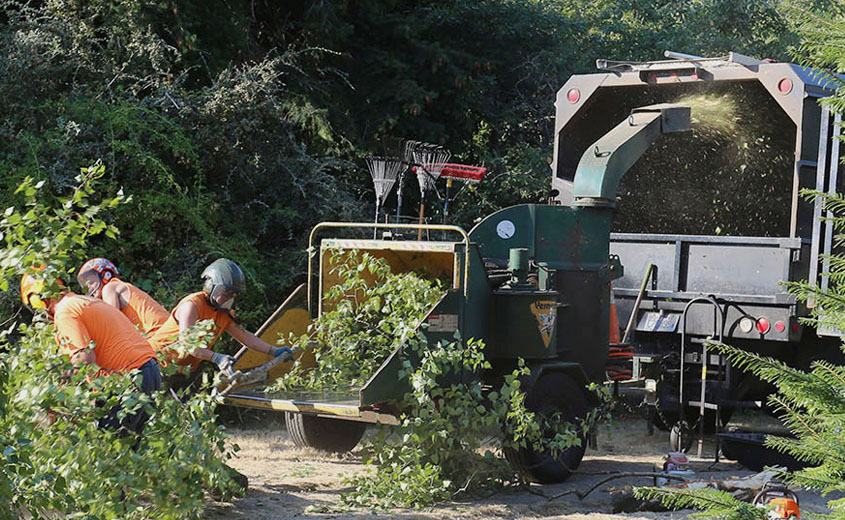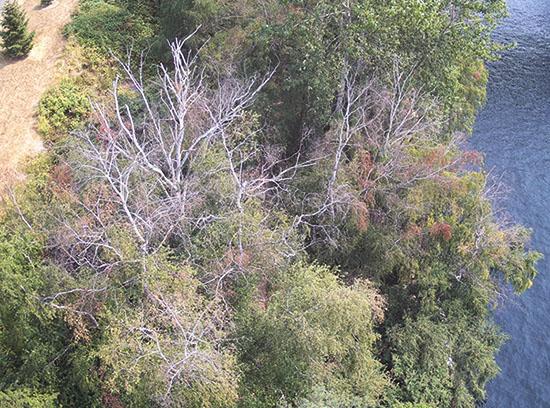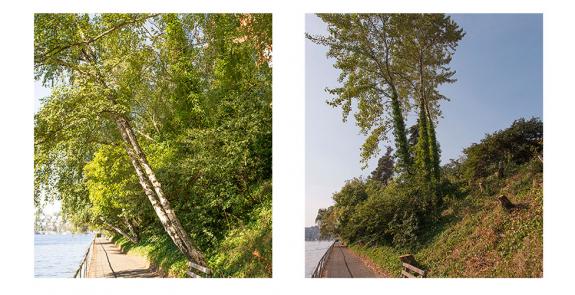More dying birch trees removed

With record-breaking heat waves and more 90-degree-plus days each summer, increasing temperatures are killing many of our region’s trees. Birch trees, prized for their silvery bark, are becoming more vulnerable to a destructive pest, altering our region’s streets, green spaces and landscapes — including the UW campus.
Grounds crews with UW Facilities recently removed 70 dying birch trees from campus. This followed the removal of 45 birches in 2018. Of the 426 birches that were part of a 2006 campus inventory, 162 have been removed or are slated for removal.
The culprit is the bronze birch borer, a beetle that lays eggs in the crevices of birch trees. Their larvae hatch and bore through the bark to feed on a tree’s vascular tissues, cutting it off from nutrients and hydration.
You can tell whether a birch has been infested by the bronze birch borer by the D-shaped exit holes where the adult beetles have emerged. A birch with bare leaves at the top is another sign. Once you see that, the tree has begun to die and there is little you can do to save it, said UW arborist Sara Shores.
The latest tree removal took place on UW land on the Montlake Cut, near the University Bridge and behind the UW Medical Center. It’s a special part of campus, said Sean Walters-Heart, a UW gardener who takes care of the landscape there.
“The area is more hospital- and public health–focused, and so many people utilize this space to get a breath of fresh air, see the water, relax, contemplate and reflect,” he said. “It's sad for so many trees to go that are already so big and providing a bit of woodland aspect to the area.”
Blame the beetle — but don’t forget climate change
The birch trees in this area were especially vulnerable to the bronze birch borer because of the lack of water and the sun exposure they received being on a south-facing slope. But the problem isn’t isolated to the UW campus. Birches are dying across the state, the Pacific Northwest and beyond. Shores gets calls from across the region asking about birches and advice about how to save them.
Why are so many birches dying? Climate change is taking its toll, allowing the bronze birch borer to strike.
“The bugs like stressed-out trees,” Shores said. “And everything connected to climate change — the heat, the duration of hot days, the change in the hottest temperature and the length of time that the temperatures are very hot — just adds more and more stress.”
While climate change is making birch trees more vulnerable, not all birch trees are vulnerable to the bronze birch borer. River birches, which have a red bark, are resistant to the beetle.
The bronze birch borer is a native insect species, and it evolved to attack dying North American birches, leaving healthy North American birches alone, said Patrick Tobin, an insect ecologist and associate professor of environmental and forest sciences at the UW.
He said he suspected the birches dying due to the bronze birch borer are non-native species from Europe or Asia, which lack adequate defenses. Shores confirmed that the birches removed along the Montlake Cut were the European species.
We need trees more now than ever
Climate change makes it even more important that we invest in our trees, Shores said. They provide shade in the summer and block the wind in the winter, cutting down on the need for heating and other energy costs.
The UW Grounds team is trying to save some campus birch trees, such as those along Mary Gates Memorial Drive near the UW’s Center for Urban Horticulture, by treating them with pesticides. While that treatment is costly and might not be the best option for everyone, birch owners can help their trees by making sure they are as healthy as possible, with adequate mulch and hydration.
UW gardeners are also working to make sure trees continue to be a part of the landscape behind the UW Medical Center - Montlake. Instead of birches, though, they’ll plant a species that can thrive in higher temperatures.
For Kellie Dean, a UW gardener who works on that part of campus alongside Walters-Heart, removal and planting are all a part of the circle of life on campus.
"I'm sad to see the trees go, but at the same time, I'm excited about what we’re going to bring in,” said Dean, who has worked at the UW for 15 years. “It's fun to pick something new or something that isn't susceptible to diseases. It opens up a whole range of trees to pick from."
She pointed out that a house across the Montlake Cut will have less privacy without the cover of trees, but passers-by will now get a better view of the University Bridge.
“It’s the good and the bad all together.”





